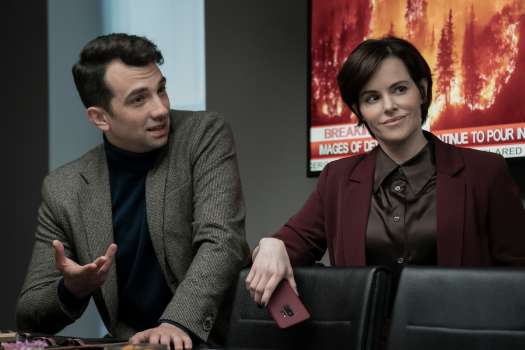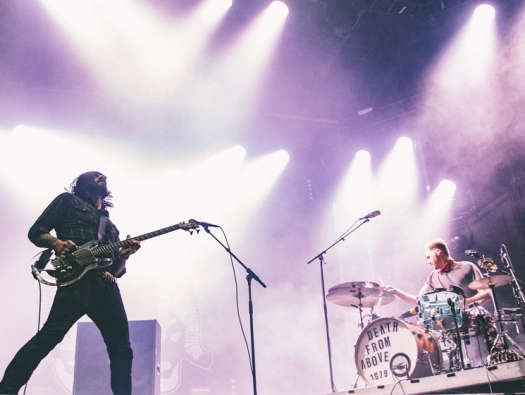Two questions sprang to mind when details of this film were announced. One: could Hugh Laurie find there's life after House in this, his first film role since the hit series concluded? Two: could the tightly-written and acclaimed novel by New Zealand author Lloyd Jones (Mister Pip) be given fresh life on the big screen? The answers to both are decidedly in the affirmative in this well-crafted and frequently moving work.
Laurie was an obvious choice for the role of Mr. Watts, an eccentric, rumpled Englishman who's the sole white in a war-ravaged community on the Pacific island of Bougainville. He takes it upon himself to start teaching the village's children, using Dickens' Great Expectations as a way to engage them. As the film depicts, however, the road to hell is paved with good intentions (or great expectations) and his project brings death and destruction to the community.
Laurie acquits himself well, especially in a scene where he buries his wife, but stealing the film is the luminous performance of acting novice Xzannjah Matsi. She plays Matilda, a 12-year-old girl who is Watts's prize pupil, and it is through her eyes and vivid imagination that we see much of the film. She carries Mr. Pip in much the same way another young unknown, Keisha Castle-Hughes, did in another New Zealand film, Whale Rider, a decade ago.
Almost as impressive is the actress portraying Matilda's mother, Dolores (Healesville Joel), and the fact that the two are mother and daughter in real life helps account for their onscreen empathy. Given that the film is officially a New Zealand production, it's surprising that the New Zealand setting of a key late chapter in the book is replaced by a London location in the film. Still, the scenes do let wonderful Kiwi actress Kerry Fox (An Angel At My Table, Shallow Grave) shine as Watts's first wife.
Pulling double duty as both screenwriter and director of Mr. Pip is Andrew Adamson, best known for his direction of two Shrek movies and the Chronicles of Narnia franchise. This may be dramatically different fare, but his facility for fantasy is confirmed with vivid scenes that transport Matilda back into Dickensian times alongside Pip, the Great Expectations protagonist and a character with whom she deeply identifies.
Adamson's screenplay adheres closely to the novel; he captures its rather languid pace, one sometimes violently shattered with the arrival of brutal soldiers out to quell an insurgency. The novel and film are rooted in a very real setting: a bloody conflict in the early '90s between Bougainvilleans protesting the rapacious copper mining of their island and the Papua New Guinea army. There are shocking and stomach-churning scenes in Mr. Pip, but Adamson deserves credit for avoiding anything gratuitous.
The production values are of the highest order, as you'd expect with the participation of such Oscar-winning The Lord of the Rings alumni as production designer Grant Major and costume designer Ngila Dickson. The cinematography of John Toon (Glory Road, Sunshine Cleaning) is also regularly breathtaking.
One flaw is the occasional overwrought nature of the score by Harry Gregson-Williams (Shrek). Dramatic source material and a stunning physical setting do not need to be this loudly punctuated.
A powerful and poetic film, Mr. Pip deserves attention.
(Eyewerks)Laurie was an obvious choice for the role of Mr. Watts, an eccentric, rumpled Englishman who's the sole white in a war-ravaged community on the Pacific island of Bougainville. He takes it upon himself to start teaching the village's children, using Dickens' Great Expectations as a way to engage them. As the film depicts, however, the road to hell is paved with good intentions (or great expectations) and his project brings death and destruction to the community.
Laurie acquits himself well, especially in a scene where he buries his wife, but stealing the film is the luminous performance of acting novice Xzannjah Matsi. She plays Matilda, a 12-year-old girl who is Watts's prize pupil, and it is through her eyes and vivid imagination that we see much of the film. She carries Mr. Pip in much the same way another young unknown, Keisha Castle-Hughes, did in another New Zealand film, Whale Rider, a decade ago.
Almost as impressive is the actress portraying Matilda's mother, Dolores (Healesville Joel), and the fact that the two are mother and daughter in real life helps account for their onscreen empathy. Given that the film is officially a New Zealand production, it's surprising that the New Zealand setting of a key late chapter in the book is replaced by a London location in the film. Still, the scenes do let wonderful Kiwi actress Kerry Fox (An Angel At My Table, Shallow Grave) shine as Watts's first wife.
Pulling double duty as both screenwriter and director of Mr. Pip is Andrew Adamson, best known for his direction of two Shrek movies and the Chronicles of Narnia franchise. This may be dramatically different fare, but his facility for fantasy is confirmed with vivid scenes that transport Matilda back into Dickensian times alongside Pip, the Great Expectations protagonist and a character with whom she deeply identifies.
Adamson's screenplay adheres closely to the novel; he captures its rather languid pace, one sometimes violently shattered with the arrival of brutal soldiers out to quell an insurgency. The novel and film are rooted in a very real setting: a bloody conflict in the early '90s between Bougainvilleans protesting the rapacious copper mining of their island and the Papua New Guinea army. There are shocking and stomach-churning scenes in Mr. Pip, but Adamson deserves credit for avoiding anything gratuitous.
The production values are of the highest order, as you'd expect with the participation of such Oscar-winning The Lord of the Rings alumni as production designer Grant Major and costume designer Ngila Dickson. The cinematography of John Toon (Glory Road, Sunshine Cleaning) is also regularly breathtaking.
One flaw is the occasional overwrought nature of the score by Harry Gregson-Williams (Shrek). Dramatic source material and a stunning physical setting do not need to be this loudly punctuated.
A powerful and poetic film, Mr. Pip deserves attention.




